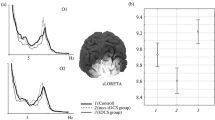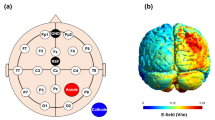Abstract
The EEG power spectra in the main bands (4 to 20 Hz) were compared during transcranial direct current stimulation (tDCS) treatment in children with mental development disorders of perinatal origin. In resting state with the eyes closed, a shift in the average frequency of α activity in the parieto-occipital area (from 9 to 10 Hz) and an increase in the spectral power stronger in the right hemisphere were observed. With the eyes open and closed, a decrease in the β range power spectrum in the right posterior temporal cortex was observed in children undergoing tDCS treatment. The power spectra of θ activity with a frequency of 4–5 Hz in the left posterior-temporal area with the eyes open showed negative correlation with age.



Similar content being viewed by others
REFERENCES
Bashina, V.M., Gorbachevskaya, N.L., Simashkova, N.V., et al., Clinical, neurophysiological, and differential-diagnostic aspects of the study of severe forms of early childhood autism, Zh. Nevrol. Psikhiatr. im. S.S. Korsakova, 1994, vol. 94, no. 4, p. 68.
Troitskaya, L.A., Speech disorders in children with epilepsy, Zh. Nevrol. Psikhiatr. im. S.S. Korsakova, 2005, vol. 105, no. 8, p. 14.
Machinskaya, R.I. and Kurgansky, A.V., Frontal bilateral synchronous theta waves and the resting EEG coherence in children aged 7–8 and 9–10 with learning difficulties, Hum. Physiol., 2013, vol. 39, no. 1, p. 58.
Zavadenko, N.N. and Nemkova, S.A., Narusheniya razvitiya i kognitivnye funktsii u detei s zabolevaniyami nervnoi sistemy (Disorders of Development and Cognitive Functions in Children with Nervous System Disorders), Moscow: Ross. Nats. Issled. Med. Univ. im. N.I. Pirogova, 2016.
Simashkova, N.V., Klyushnik, T.P., Yakupova, L.P., et al., Kliniko-biologicheskie aspekty rasstroistv autisticheskogo spektra (Clinical-Biological Aspects of Autism Spectrum Disorders), Moscow: GEOTAR-Media, 2016.
Akshoomoff, N., Farid, N., Courchense, E., and Hass, R., Abnormalities on the neurological examination and EEG in young children with pervasive developmental disorders, J. Autism Dev. Disord., 2007, vol. 37, no. 5, p. 887.
Mathewson, K.J., Jetha, M.K., Drmic, I.E., et al., Regional EEG alpha power, coherence, and behavioral symptomathology in autism spectrum disorder, Clin. Neurophysiol., 2012, vol. 123, p. 1798.
Arns, M., Conners, C.K., and Kraemer, H.C., A decade of EEG theta/beta ratio research in ADHD: a meta-analysis, J. Atten. Disord., 2013, vol. 17, no. 5, p. 374.
Strzelecka, J., Electroencephalographic studies in children with autism spectrum disorders, Res. Autism Spectrum Disord., 2014, vol. 8, p. 317.
Amatachaya, A., Jensen, M.P., Patjanasoontorn, N., et al., The short-term effects of transcranial direct current stimulation on electroencephalography in children with autism: a randomized crossover controlled trial, Behav. Neurol., 2015, vol. 2015, art. ID 928631, p. 11.
Mikropolyarizatsiya u detei s narusheniem psikhicheskogo razvitiya ili kak podnyat’ planku ogranichennykh vozmozhnostei (Micropolarization in Children with Mental Disorders or How to Raise the Level of Limited Potential?), Kozhushko, N.Yu., Ed., St. Petersburg: KARO, 2011.
Kozhushko, N.Yu., Evdokimov, S.A., Matveev, Yu.K., Tereshchenko, E.P., and Kropotov, Yu.D., Study of local EEG specificities in children with mental development disorders using independent component analysis, Hum. Physiol., 2014, vol. 40, no. 5, p. 497.
Kozhushko, N.Yu., Evdokimov, S.A., and Matveev, Yu.K., Neurophysiological markers of abnormal development in children with mental disorders, Hum. Physio-l., 2018, vol. 44, no. 2, p. 202.
Ille, N., Berg, P., and Scherg, M., Artifact correction of ongoing EEG using spatial filters based on artifact and brain signal topographies, J. Clin. Neurophysiol., 2002, vol. 19, no. 2, p. 113.
Tereshchenko, E.P., Ponomarev, V.A., Kropotov, Yu.D., and Müller, A., Comparative efficiencies of different methods for removing blink artifacts in analyzing quantitative electroencephalogram and event-related potentials, Hum. Physiol., 2009, vol. 35, no. 2, p. 241.
Kozhushko, N.Y., Kropotov, Y.D., Matveev, Y.K., Semivolos, V.I., Tereshchenko, E.P., and Cholyavin, A.I., Brain structural and functional characteristics in children with mental disorders and the possibilities of transcranial direct current stimulation, Hum. Physiol., 2014, vol. 40, no. 4, p. 383.
Leutin, V.P. and Nikolaeva, E.I., Funktsional’naya asimmetriya mozga: mify i deistvitel’nost’ (Functional Asymmetry of Brain: Myths and Reality), St. Petersburg: Rech’, 2005.
Dobrokhotova, T.A., Neiropsikhiatriya (Neuropsychistry), Moscow: Binom, 2013, 2nd ed.
Nikolaenko, N.N., Rukovodstvo po meditsinskoi psikhologii (Manual on Medical Psychology), St. Petersburg: Nauka, 2017.
Semenovich, A.V., Neiropsikhologicheskaya korrektsiya v detskom vozraste (Neuropsychological Correction in Childhood), Moscow: Genezis, 2017.
Khrakovskaya, M.G., Afaziya, agnoziya, apraksiya. Metodiki vosstanovleniya (Aphasia, Agnosia, and Apraxia: Rehabilitation Methods), St. Petersburg: Nestor-Istoriya, 2017.
Buklina, S.B. and Batalov, A.I., Improvement of speech function in patients with aphasia: the right hemisphere, an enemy or a friend? Hum. Physiol., 2018, vol. 44, no. 2, p. 161.
Floris, D.L., Chura, L.R., Holt, R.J., et al., Psychological correlates of handedness and corpus callosum asymmetry in autism: the left hemisphere dysfunction theory revisited, J. Autism Dev. Disord., 2013, vol. 43, no. 8, p. 1758.
Lindell, A.K. and Hudry, K., Atypicalities in cortical structure, handedness, and functional lateralization for language in autism spectrum disorders, Neuropsychol. Rev., 2013, vol. 23, no. 3, p. 257.
Anglade, C., Thiel, A., and Ansaldo, A.I., Complementary role of the cerebral hemispheres in recovery from aphasia after stroke: a critical review of literature, Brain Inj., 2014, vol. 28, no. 2, p. 138.
Bidelman, G.M. and Howell, M., Functional changes in inter- and intra-hemispheric cortical processing underlying degraded speech perception, NeuroImage, 2016, vol. 124, p. 581.
Kozhushko, N.Ju., Nagornova, Zh.V., Evdokimov, S.A., et al., Specificity of spontaneous EEG associated with different levels of cognitive and communicative dysfunctions in children, Int. J. Psychophysiol., 2018, vol. 128, p. 22.
ACKNOWLEDGMENTS
We are grateful to Yu. K. Matveev (Bechtereva Institute of the Human Brain) for the valuable assistance with tDCS.
Author information
Authors and Affiliations
Corresponding author
Ethics declarations
Conflict of interests. The authors declare that they have no open or potential conflicts of interests related to the publication of the present article.
Statement of compliance with standards of research involving humans as subjects. All procedures involving human participants were in accordance with the ethical standards of the 1964 Helsinki Declaration and its later amendments and were approved by the Committee on Bioethics of the Bechtereva Institute of the Human Brain. Informed consent was obtained from all individual participants involved in the study. All participants signed a written informed consent form after being informed about the potential risks and advantages, as well as about the design of the study.
Additional information
Translated by D. Timchenko
Rights and permissions
About this article
Cite this article
Kozhushko, N.Y., Evdokimov, S.A. Age-Related Changes in EEG Formation during Transcranial Direct Current Stimulation. Hum Physiol 45, 364–369 (2019). https://doi.org/10.1134/S0362119719040054
Received:
Revised:
Accepted:
Published:
Issue Date:
DOI: https://doi.org/10.1134/S0362119719040054




